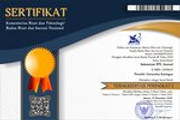ELT LEARNING MEDIA FOR YOUNG LEARNERS: FAMILY-THEMED PICTURE STORIES
Abstract
The study aims at investigating whether the family-themed picture stories for young learners were valid as learning media for English Language Teaching (ELT). The researchers developed three picture stories related to family as prototypes. The research procedure was proposed by Akker, which comprised analysis, design, evaluation, and revision. The validity was reviewed by the experts of content, instructional design and media or product design. The mean of content validity of three prototypes is 4.26 which is at very highly valid level. In term of construct validity, the average score of construct validity of three stories is 4.23 which is at very highly valid level. The average score of media or product design validity of the prototypes is 4.36 which is at very highly valid level. Thus, the study result shows that, overall validities of content, construct, and media or product design of the three picture stories are 4.28, which is at very highly valid level. In conclusion, the set of family-themed picture stories as learning media are valid and categorized as very highly valid level; consequently, they are likely to facilitate Teaching English to Young Learners (TEYL).
Keywords: learning media; TEYL; picture stories
Full Text:
PDFReferences
AECT. (1972). The field of educational technology: a statement of definition. Audio-Visual Instruction, 17(8), 36-43.
Aini, W.N. (2013). Instructional media in teaching English to young learners: A case study in elementary schools in Kuningan. Journal of English and Education, 1(1), 196-205.
Akker, J.V.D. (1999). Principle and method of development research. London. In Akker, J.V.D., Branch, R.M., Gustafson, K., Nieveen, N., & Plomp, T. (Eds.), Design approaches and tools in educational and training. Dordrecht: Kluwer Academic Publisher.
Aygun, A. & Abaci, O. (2014). Examination of illustrated story books published between the year of 2004-2013 for 4-8 age group children in terms of illustration. Procedia – Social and Behavioral Sciences, 152, 94-99.
Baranowska, K. (2020). Learning most with least effort: subtitles and cognitive load. ELT Journal, 74(2), 105-115.
Brown, H.D. (2007). Principles of language learning and teaching (5th ed). New York: Pearson Education.
Collins, C. (1991). Reading instruction that increases thinking abilities. Journal of Reading, 34, 510–516.
Dewi, P. (2017). Teaching English for young learners through ICTs. Proceedings of the 2nd TEYLIN International Conference, 149-156.
Education First (2020). EF English proficiency index. Retrieved from www.ef.com/epi
Hermawan, A.H., Riyana, C. & Zaman, B. (2007). Media pembelajaran Sekolah Dasar. Bandung: UPI Press.
Hernawan, A.H., Susilana, R. & Julaeha, S. (2013). Pengembangan kurikulum dan pembelajaran di SD. Tangerang Selatan: Universitas Terbuka.
Inharjanto, A. & Lisnani (2020). Developing coloring books to enhance reading comprehension competence and creativity. Advances in Social Science, Education and Humanities Research, 394, 7-12.
Kemdikbud (2013). Kurikulum 2013, Kompetensi dasar Sekolah Menengah Pertama (SMP)/ Madrasah Tsanawiyah (MTs).
Klingner, J. K., Vaughn, S. & Boardman, A. (2007). Teaching reading comprehension to students with learning difficulties. New York, NY: The Guilford Press.
Kubiszyn, T., & Borich, G. (1993). Educational testing and measurement: Classroom application and practice (4th ed.). New York: Harper Collins College Publisher.
Liao, G. (2011). On the development of reading ability. Theory and Practice in Language Studies, 1(3), 302-305, DOI: 10.4304/tpls.1.3.302-305.
Maili, S.N. (2018). Bahasa Inggris pada Sekolah Dasar: Mengapa perlu dan mengapa dipersoalkan. Judika (Jurnal Pendidikan Unsika), 6(1), 23-28.
Musthafa, B. (2010). Teaching English to young learners in Indonesia: Essential requirements. Educationist Journal, 4(2), 120-125.
Negara, H.S. (2014). Penggunaan komik sebagai media pembelajaran terhadap upaya meningkatkan minat Matematika siswa Sekolah Dasar (SD/MI). Jurnal Terampil, 3(3), 66-76.
Pinter, A. (2011). Children learning second languages. Hampshire: Palgrave MacMillan
Putri, M.A, Harto, S. & Moecharam, N.Y. (2017). Promoting character education in EFL classroom: Using children’s literature as a teaching material. Journal of English and Education, 5(2), 163-169.
Reftyawati, D. (2007). Providing instructional media for teaching language to young learners. Lingua – Jurnal Bahasa & Sastra, 18(1), 21-28.
Rusiana & Maharani, M.M. (2019). Helping young learners to acquire English pre-reading skills through reading stories. Proceedings of the 3rd International Conference on TEYLIN, 98-103.
Sanaky, H.A.H. (2009). Media pembelajaran. Yogyakarta: Safiria Insania Press.
Saputri, H.M. (2017). Indonesian culture-based comic for teaching young learners in Indonesia. Proceedings of the 2nd TEYLIN International Conference, 122-130.
Scott, W.A & Ytreberg, L.H. (2004). Teaching English to children. Essex: Pearson Education Limited.
Siswanto, A. (2017). Teaching English to young learners: A reflection form Englaoshi community. Proceedings of the 2nd TEYLIN International Conference, 31-34.
Sopian, Inderawati, R. & Petrus, I. (2019). Developing e-learning based local-foklores for eight graders. English Review: Journal of English Education, 8(1),101-112.
DOI: https://doi.org/10.25134/erjee.v8i1.1813
Sugiyono. (2010). Metode penelitian pendidikan pendekatan kuantitatif, kualitatif, dan R&D. Bandung: Alfabeta
Suharsih, S. & Hamidiyah, A. (2012). Realia: The effective media for teaching English for EYL. Proceedings of Teaching English for Young Learners in Indonesia (TEYLIN) 2, 6-14.
Sundayana, R. (2015). Media dan alat peraga pembelajaran Matematika. Bandung: Alfabeta.
Sutardi, A. (2011). Pengembangan kurikulum bahasa Inggris berbasis teknologi informasi dan komunikasi (TIK) SD Tulangampiang, Denpasar, Bali dan implementasinya. Jurnal Pendidikan dan Kebudayaan, 17(1), 70-83.
Tessmer, M. (1993). Planning and conducting formative evaluation. Philadelphia, PA: Kogan Page.
Ur, P. (1996). A course in language teaching: Practice and theory. Cambridge Teacher Training and Development, Cambridge: Cambridge University Press.
Widiastuti, I., Kusmaryati, S.E. & Romadlon, F.N. (2019). Illustrated colored pictures: Improving vocabulary mastery for young learners. Proceedings of the 3rd International Conference on TEYLIN, 68-75.
Zulkardi (2005). Pendidikan Matematika di Indonesia: Beberapa permasalahan dan upaya penyelesaiannya. Makalah disampaikan pada pengukuhan guru Besar FKIP Universitas Sriwijaya
DOI: https://doi.org/10.25134/ieflj.v7i1.3987
Refbacks
- There are currently no refbacks.

This work is licensed under a Creative Commons Attribution-ShareAlike 4.0 International License.

